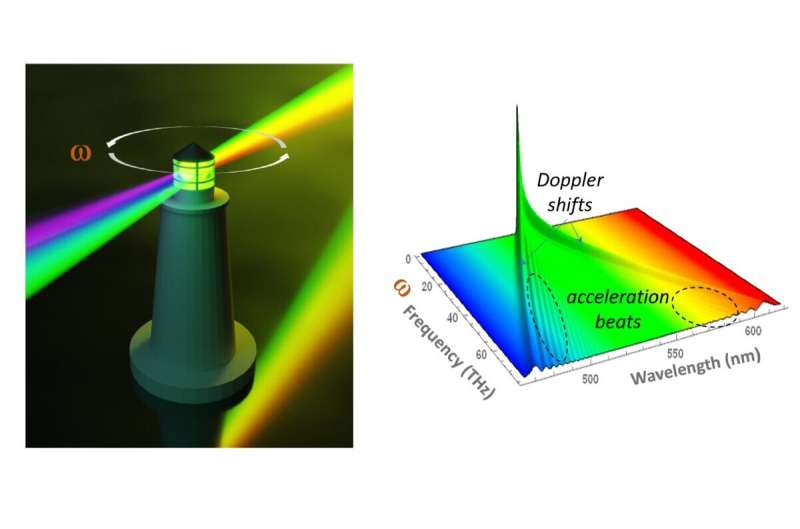This article has been reviewed according to Science X's editorial process and policies. Editors have highlighted the following attributes while ensuring the content's credibility:
fact-checked
peer-reviewed publication
proofread
'Acceleration beats' shine bright light on a novel universal modulation regime in a semiconductor-based laser

Researchers at the Paul-Drude-Institute for Solid State Electronics (PDI) have observed a novel modulation regime characterized by the emergence of previously unseen "acceleration beats" in a modulated semiconductor-based laser.
As they detail in a paper published today in Nature Communications, the key—and somewhat counterintuitive—feature of this novel regime is the ability to coherently manipulate quantum systems using modulation periods longer than the coherence time, provided that the modulation amplitude is large enough.
Harmonic modulation of light sources, such as lasers, is the cornerstone of many modern and emergent telecommunications technologies. In this regard, two regimes of modulation are well-known: the adiabatic regime and the non-adiabatic regime.
On the one hand, in the adiabatic regime, the coherence of light—the extent to which the light waves maintain a constant, predictable phase connection—dissipates faster than the modulation cycle (i.e., the inverse of the modulation frequency [EF1]).
On the other hand, in the non-adiabatic regime, several modulation cycles fit within the system's coherence time. The latter regime is particularly important for the coherent manipulation of quantum systems, but requires high-frequencies typically in the GHz range.
However, controlling modulations—as is necessary to manipulate these systems for technological applications—requires a delicate balance. According to Alexander S. Kuznetsov, the study's lead author, what has been largely overlooked in previous studies is the amplitude of the modulation, or the strength with which the system is shaken.
"The main obstacle has been the fact that the greater the shaking, the faster the system loses its coherence," he said. "Now, for what we believe is the first time, the PDI team has demonstrated what happens when a laser-like opto-electronic resonance is modulated with the extreme modulation amplitudes, and reveals a novel aspect of such modulation, caused by the acceleration. The modulation is neither adiabatic, nor non-adiabatic, but a fundamentally different regime."
The experimental studies, conducted by Kuznetsov, introduced high-amplitude harmonic modulation to the emission energy of a semiconductor-based, micron-sized coherent light source. They observed that these extreme changes in modulation amplitude led to the emergence of "acceleration beats"—spectral oscillations related to varying rates of energy change (i.e., the acceleration) of the source rather than to the velocity of energy changes, as is the case for most physical systems under low-amplitude perturbation.
Paulo V. Santos, who developed the model for the acceleration beats, likens them to the effect produced by a rapidly rotating light in a lighthouse: When at rest, the light source will be assumed to have a narrow spectral distribution—perhaps a single, well-defined green beam of light. But when the source rotates, one first sees, instead of a single beam, two beams with different colors.
This color change results from the Doppler shift: change in the frequency (or wavelength) perceived by an observer when the source moves towards or away from him, which depends on the movement velocity.
"If the rotation frequency further increases, one starts to see small wiggles close to the Doppler-shifted emission," Santos said. "In contrast to the Doppler shifts, which result from motion at constant velocity, these wiggles arise from fast rates of velocity changes, i.e., from accelerated motion."
This observed effect is universal, meaning that it could be observed in any kind of system under harmonic modulation. However, these results are the first known experimental demonstration of the acceleration beats, owing to the ability to rapidly modulate a solid-state system with large-enough amplitude. This is corroborated by the further finding that the beats could have already been predicted using existing models.
Central to the experiment's design was a semiconductor microcavity—essentially a box made of layered semiconductor materials—developed by Klaus Biermann, which the researchers used to observe laser light emitted by a confined polariton condensate.
"One key ingredient is the confined light-matter polariton condensates in semiconductor microcavities are ideal bright sources, with tunable coherence and enhanced susceptibility to the monochromatic acoustic fields," said Kuznetsov.
"Another ingredient is piezoelectrically generated acoustic waves that can modulate the energy of the condensate with amplitudes that exceed by up to two orders of magnitude the modulation quantum."
The fundamental character of the discovery raises important questions about whether acceleration beats can be observed under other extreme conditions in cosmic phenomena and in high-energy particles.
While potential applications of this new regime have yet to be explored, the researchers say the study opens new possibilities to produce high-frequency spectral features using much lower modulation frequency and to develop new protocols for the control of quantum systems.
More information: A. S. Kuznetsov et al, Acceleration-induced spectral beats in strongly driven harmonic oscillators, Nature Communications (2024). DOI: 10.1038/s41467-024-49610-5
Journal information: Nature Communications
Provided by Paul-Drude-Institut für Festkörperelektronik





















